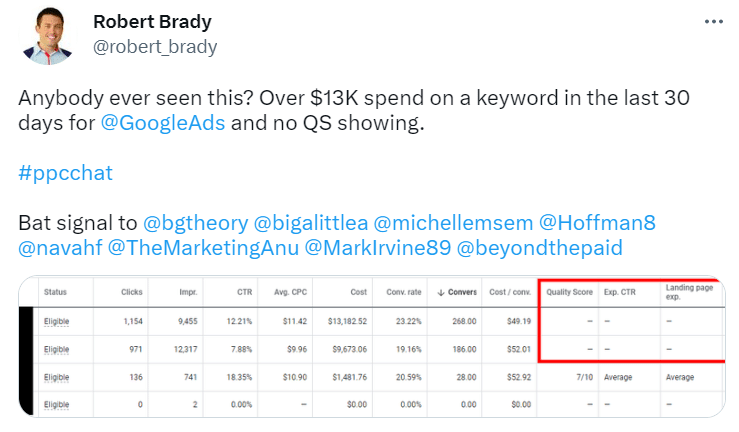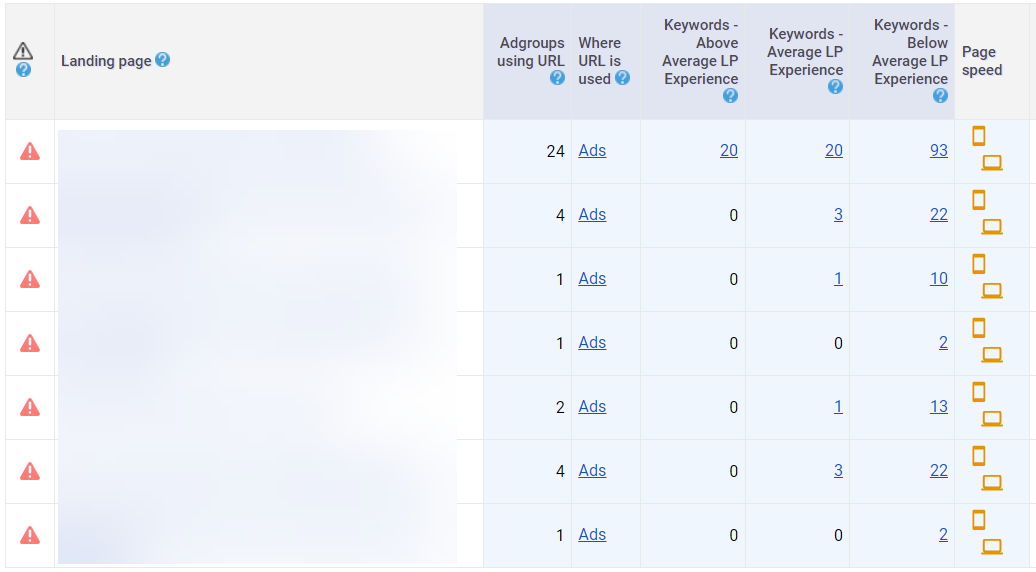Quality score. Two words that strike fear in the hearts of paid search professionals everywhere.
OK, not really.
But quality score can be a confusing metric that sparks debate.
A vanity metric?
Some practitioners contend that quality score is a vanity metric.

Others view quality score as a KPI to be optimized and reported regularly.
The discussion rages on.
There’s also the question of whether quality score is a factor in ad rank.
(Spoiler alert, it is indeed a factor.)
Quality score might be the most confusing PPC metric ever.
Defining quality score
Let’s take a step back and talk about what quality score actually is.
In this article by Navah Hopkins, she defines quality score as “a score calculated by Google and Microsoft alongside your bid to determine your ad rank.” To understand the basics of quality score, read this excellent article if you haven’t already.
Bottom line: quality score determines where your ad appears on the page and how much you pay for each click.
Is quality score important?
Should you focus on improving quality score? Or is it really just a vanity metric?
Google’s official help files say this:
“Quality Score is calculated based on the combined performance of 3 components:
- Expected clickthrough rate (CTR): The likelihood that your ad will be clicked when shown.
- Ad relevance: How closely your ad matches the intent behind a user’s search.
- Landing page experience: How relevant and useful your landing page is to people who click your ad.
Each component is evaluated with a status of “Above average,” “Average,” or “Below average.” This evaluation is based on a comparison with other advertisers whose ads showed for the exact same keyword, over the last 90 days.
If one of these components has a status of “Average” or “Below average,” this may indicate an opportunity to make improvements.”
– About Quality Score, Google Ads Help
From reading the above, Google thinks it’s important for advertisers to improve their quality score.
However, we all know that Google often tells advertisers to focus on things that make Google money but don’t help the advertiser’s bottom line.
Some paid search pros posit that quality score is significant as a metric. In this 2013 article, Larry Kim claims that quality score is “king of the KPIs.”
However, Kim is making a circular argument. He rightly states that quality score can impact CPA.
Yes, it does.
Quality score impacts CPC, so it also impacts CPA. If you’re paying a high CPC, then by definition, you will pay more for each conversion than an advertiser paying a low CPC.
It’s basic math. You could just as easily argue that an advertiser should reduce their max CPCs to reduce CPA.
It’s not really that simple, but is the time spent focusing on quality score worth it?
What the experts say
Many experts in the field believe it is.
Brad Geddes, founder of PPC tool Adalysis, has written several posts about improving quality scores. The tool also features modules to help advertisers improve their quality score, showing quality score data at various levels.

In one article, Geddes illustrates how to improve quality score by moving low quality score keywords to a new ad group.
Optmyzr, another PPC tool created by former Googler Fred Vallaeys, also features modules to improve quality score.
In this article from late 2022, Ashwin Balakrishnan of Optmyzr states that quality score is still important.
I have a great deal of respect for both Geddes and Vallaeys. They’ve been mentors of mine in the search industry.
If these tool founders feel that quality score is so important that they’ve invested time and resources building modules to improve it, it must be important. Right?
Then why do advertisers say quality score is a vanity metric?
There are several reasons. First off, there’s the fact that Google doesn’t even show a quality score for every keyword.
Robert Brady showed an example of a keyword spending over $13,000 in 30 days with no quality score showing.

I’ve seen similar things in my accounts – keywords with large spend yet no quality score showing.
Google Ads liaison Ginny Marvin said quality scores will only show for keywords with “enough” exact match impressions. Keywords also need “recent” exact match impressions.
If quality score is so important, why doesn’t it appear for every keyword? And how does one optimize for data we don’t have?
Next, there’s B2B, the world I live in.
B2B keywords are notorious for having low quality scores. While we’ll never know all the reasons for this, it likely has to do with a few factors:
- Low search volume compared to B2C searches.
- Niche, industry-specific search terms that Google doesn’t understand.
- Ambiguity with B2C searches (e.g., “security solutions,” “renewable energy,” etc.).
- Competition – many deep-pocketed advertisers vying for relatively few ambiguous searches.
- Search engine algorithms don’t understand intent, especially in B2B.
The last bullet is especially important (and frustrating). Because:
- As Geddes puts it, “algorithms don’t think – they just examine numbers.”
- B2B volume is lower than B2C.
- There’s overlap with B2C.
Ultimately, engine algorithms don’t understand intent, and B2B advertisers are often punished with low quality scores – sometimes even on brand terms.
Hopkins’ quality score article states that:
“[T]hese scores are determined based on how your campaign did against comparable advertisers. However, depending on the advertisers Google chooses [to] compare you with, it is possible for a good CTR sometimes to get downgraded to average (or even below average).”
Here’s an example from one of our clients:

We have three brand keywords with middling quality scores.
Two of the three keywords have double-digit CTR, yet one of the keywords – for a “free account,” no less – shows that the expected CTR is below average!
It’s enough to make an advertiser throw up their hands in frustration.
As a result, we often do not strongly focus on optimizing quality score for our B2B clients.
Dealing with engines that don’t understand ambiguity or B2B is just banging your head against the wall. It takes time away from other, more leveraged optimizations like landing page and ad copy testing.
Settling the (quality) score
We’re back to the original question: Is quality score truly important?
It is, but maybe not in the way you think.
Quality score shouldn’t be a KPI on its own. You should not report to clients or obsess over it daily.
But you shouldn’t ignore it either. Instead, use quality score directionally. Let low quality scores point you to other optimizations.
Use tightly themed ad groups
For example, small, tightly-themed ad groups are still important.
We’ve improved quality score (and performance) by splitting up large ad groups into smaller ad groups around a theme and using ad copy that mirrors the theme.
Even in today’s RSA world, tightly themed ad groups still matter.
Improve your landing pages
Another way to use quality score directionally is to improve landing pages.
This is an often-overlooked optimization that can pay huge dividends in quality score and in increasing conversion rates.
Here’s an example from the same client I featured above, the one with lower-than-expected quality scores for brand:

This screenshot from Adalysis shows several landing pages with below-average landing page experiences.
Adalysis links to the PageSpeed Insights tool, a free and useful tool to diagnose issues with page load speeds. Here’s how one of the client’s pages scored:

33 out of 100. Not so great.
It’s easy to see why this landing page is pulling down quality score – and user experience along with it.
The PageSpeed Insights tool offers diagnostics for “opportunities” to improve pages:
In this case, unused elements or blocking issues slow down page load time.
Clicking the down arrow next to the “estimated savings” for each element gives step-by-step instructions on how to fix the issue.
Many PPC marketers might view the PageSpeed Insights tool as an “SEO thing.” It’s unfamiliar to us.
But, as Hopkins points out in her article, “SEO is integral to a healthy PPC performance – and a holistic search marketing strategy.”
See if you can work with your client’s SEO team (or web dev team if they don’t have an SEO team) to improve their landing pages.
Even just speeding up page load can positively impact quality score and performance.
So is quality score a vanity metric? In a way, it is – especially for B2B advertisers. But it’s also a useful tool for improving PPC performance.
The post Quality score in paid search: Vanity or valuable? appeared first on Search Engine Land.
https://ift.tt/Uau5r6k
from Search Engine Land https://ift.tt/t0YqV7D
via IFTTT







No comments:
Post a Comment
Thanks and response you soon